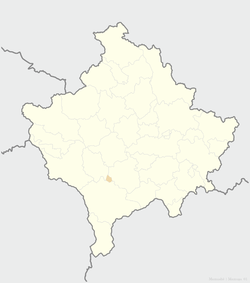Turkish population
The Turkish population refers to the number of ethnic Turkish people in the world. During the Seljuk (1037–1194) and Ottoman (1299–1923) eras ethnic Turks were settled across the lands conquered by the two empires. In particular, the Turkification of Anatolia (modern Turkey) was the result of the Battle of Manzikert in 1071 and the formation of the Sultanate of Rum. Thereafter, the Ottomans continued Turkish expansion throughout the regions around the Black Sea and the Mediterranean Sea. Consequently, today the Turkish people form a majority in Turkey and Northern Cyprus. There are also significant Turkish minorities who still live in the Balkans, the Caucasus, and the Levant, and North Africa.
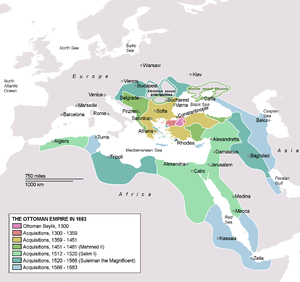
More recently, the Turkish people have emigrated from their traditional areas of settlement for various reasons, forming a large diaspora. From the mid-twentieth century onwards, unskilled workers from Turkey settled mainly in German and French speaking countries of Western Europe, in contrast, a "brain drain" of skilled workers from Turkey migrated mostly to North America. Moreover, ethnic Turks from other traditional areas of Turkish settlement have emigrated mostly due to political reasons. For example, the Meskhetian Turks were deported to Central Asia from Georgia in 1944; Turkish Cypriots have emigrated mostly as refugees to the English-speaking world during the Cyprus conflict and its immediate aftermath; Cretan Turks have significant populations in the Arab world as a result of being expelled from Greece; etc..
Traditional areas of Turkish settlement
Turkish majorities
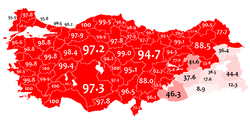
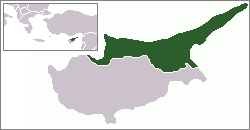
| Country | Official State census figures | Other estimates | Constitution recognition | See also |
|---|---|---|---|---|
| N/A. The Turkish census collects data on country of birth but does not collect data on ethnicity. | 60,000,000 – 65,000,000[1][2] | The Turkish language is the official language of the Republic of Turkey, under Article 3 of the 1982 Turkish constitution. | Turkish people | |
| 286,257 (2011 Turkish Cypriot census)[3] | 300,000[4]-500,000[5] (includes Turkish Cypriots and recent Turkish settlers) | According to Article 2(2) of the 1985 constitution of the Turkish Republic of Northern Cyprus, which is only recognised by Turkey, the Turkish language is the sole official language of the break-away state.[6] | Turkish Cypriots | |
Turkish "communities"
| Country | Official State census figures | Other estimates | Constitution recognition | See also |
|---|---|---|---|---|
| 1,128 (2011 Cypriot Census)[7] | 2,000 Turkish Cypriots remain in the internationally recognized southern region of the Republic of Cyprus.[8] | Under Article 2 of the Cypriot constitution the Turkish Cypriots, alongside the Greek Cypriots, form one of the two "Communities" in Cyprus. The Turkish Cypriots are therefore recognised as equal participants of the Republic rather than as a minority. Furthermore, under Article 3, the Greek and Turkish languages are the two official languages of Cyprus.[9] Despite President Makarios III's attempt to amend the constitution and the aim to weaken the rights of Turkish Cypriots, under the 1963 Akritas plan, the original 1960 constitution is still legally in force today. | Turkish Cypriots | |
Turkish minorities
Turkish minorities in the Balkans
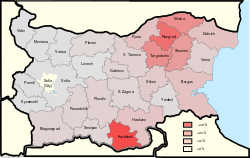
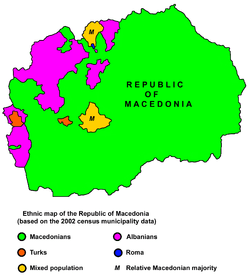
| Country | Official State census figures | Other estimates | Constitutional recognition/Minority status | Further information | Lists of Turks by country |
|---|---|---|---|---|---|
| 267 (1991 Bosnian census)[10] | 50,000[11][12] | The Turkish language is officially recognized as a minority language, in accordance with the European Charter for Regional or Minority Languages, under Article 2, paragraph 2, of the 2010 ratification.[13] | Turks in Bosnia and Herzegovina | ||
| 588,318 (2011 Bulgarian census)[14] | 750,000[11] | The Bulgarian constitution of 1991 does not mention any ethnic minorities and the Bulgarian language is the sole official language of the State. However, in accordance with Article 36(2), the Turkish minority has the right to study their own language alongside the compulsory study of the Bulgarian language. Moreover, under Article 54(1), the Turkish minority have the right to "develop their culture in accordance with his ethnic identification".[15] | Turks in Bulgaria | List of Bulgarian Turks | |
| 367 (2011 Croatian census)[16] | 2,000[17] | The Turks are officially recognised as a minority ethnic group, in accordance with the 2010 Constitution of Croatia.[18] | Turks in Croatia | ||
| 179,895 (1951 Greek census)[19][20][21] | 150,000[11] (80,000[22] to 130,000 in Western Thrace,[23][24] 10,000[25] to 15,000 in Athens,[26] 5,000 in Rhodes and Kos,[27] and 5,000 in Thessaloniki)[26] | The Turks of Western Thrace have protected status to practice their religion and use the Turkish language, in accordance with the 1923 Treaty of Lausanne. However, the other sizeable Turkish minorities in Greece have no official recognition.[28] | Turks in Greece | ||
| 18,738 (2011 Kosovar census)[29] | 30,000[30] to 50,000[11] | The Turkish language is recognized as an official language in the municipalities of Prizren and Mamuša and has minority status in Gjilan, Pristina, Vučitrn, and Mitrovica.[31] | Turks in Kosovo | ||
| 77,959 (2002 Macedonian census)[32] | 170,000–200,000[33][34] | Initially the 1988 draft constitution spoke of the "state of the Macedonian people and the Albanian and Turkish minority". Once the 1991 constitution came into force the Turkish language was used officially where Turks formed a majority in the Centar Župa Municipality and the Plasnica Municipality. Since the 2001 amendment to the constitution, the Turkish language is officially used where Turks form at least 20% of the population and hence it is also an official language of Mavrovo and Rostuša.[35] | Turks in Macedonia | ||
| 104 (2011 Montenegrin census).[36] | Turks in Montenegro | ||||
| 28,226 (2011 Romanian census)[37] | 55,000[38] to 80,000[39] | The Turkish language is officially recognized as a minority language, in accordance with the European Charter for Regional or Minority Languages, under Part III of the 2007 ratification.[13] | Turks in Romania | ||
| 647 (2011 Serbian census)[40] | Turks in Serbia | ||||
| Total | N/A | 1,300,000 (2011 estimate)[11] | Turks in the Balkans |
Turkish minorities in the Caucasus
Historical.svg.png)
| Country | Official State census figures | Other estimates | Constitutional recognition/ Minority status | Further information | Lists of Turks by country |
|---|---|---|---|---|---|
| 731 (2011 Abkhazian census)[41] | 15,000[42] | Turks in Abkhazia | |||
| Turkish minority N/A. Although the USSR censuses recorded a small number of Turks: 19 in 1970,[43] 28 in 1979,[44] and 13 in 1989,[45] they were not recorded in the 2001 Armenian census. | Turks in Armenia | ||||
| Turkish minority N/A. The 2009 Azeri census recorded 38,000 Turks;[46] however, it does not distinguish between the Turkish minority (descendants of Ottoman settlers who remained in Azerbaijan), Meskhetian Turks who arrived after 1944, and recent Turkish arrivals. | 19,000[47] (Descendants of Ottomans settlers who remained in Azerbaijan only. This does not include the much larger Meskhetian Turkish and mainland Turkish arrivals who form a part of the diaspora) | Turks in Azerbaijan | |||
| *Pre-World War II: 137,921 (1926 USSR Census).[48] The Turkish population was not recorded in later censuses; nonetheless, it is estimated that 200,000 Turks from Meskheti were deported to Central Asia in 1944.[48] *Post-World War II: The Meskhetian Turkish population in the USSR was published for the first in the 1970 census. However, by this point, the Turkish minority in Georgia had already diminished to several hundred due to the forced deportation of 1944.[48] There were 853 Turks in Georgia in 1970,[43] 917 in 1979,[44] and 1,375 in 1989.[45] *Post-USSR: Although a small number has returned to Georgia, they have not been recorded in the 2002 Georgian census. | 1,500[49][50] | Meskhetian Turks | |||
Turkish minorities in the Levant
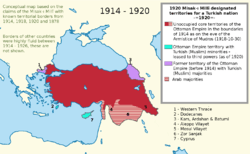
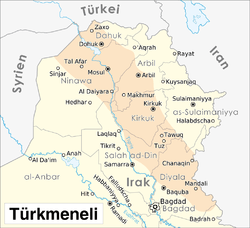
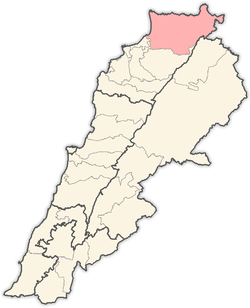
| Country | Census figures | Alternate estimates | Legal recognition | Further information | Lists of Turks by country |
|---|---|---|---|---|---|
| 567,000 or 9% of the total Iraqi population (1957 census)[51][52][53][54] | 3,000,000 (Iraqi Ministry of Planning estimate, 2013)[55][56] | In 1925 the Turks were recognised as a constitutive entity of Iraq, alongside the Arabs and Kurds, however, the minority were later denied this status.[57] In 1997 the Iraqi Turkoman Congress adopted a Declaration of Principles, Article Three of which states the following: "The official written language of the Turkomans is Istanbul Turkish, and its alphabet is the new Latin alphabet."[58][59] | Iraqi Turkmens | List of Iraqi Turks | |
| N/A | N/A | N/A | Turks in Israel | ||
| N/A | Turkish minority: Palestinian-Turkish refugees: 55,000 in Irbid[60] 5,000 near Amman[60] 5,000 in El-Sahne[60] 3,000 in El-Reyyan[60] 2,500 in El-Bakaa[60] 1,500 in El-Zerkaa[60] 1,500 in Sahab[60] | N/A | Turks in Jordan | List of Jordanian Turks | |
| N/A | 80,000[61] (plus 125,000 to 150,000 Syrian Turkmen refugees[62]) | N/A | Turks in Lebanon | List of Lebanese Turks | |
| N/A | est. West Bank: 35,000 to 40,000[63] total Palestinian-Turkish community: est.400,000 to 500,000[64] | N/A | Turks in Palestine | ||
| N/A | 500,000–3.5 million[65][66][67][68] | N/A | Syrian Turkmens | List of Syrian Turks | |
Turkish minorities in North Africa
| Country | Census figures | Alternate estimates | Legal recognition | Further information | Lists of Turks by country |
|---|---|---|---|---|---|
| N/A | 5%[69][70] to 25% of Algeria's population[70][71] 600,000 to 2 million[72][69][73][74] up to 9.5 million (including partial Turkish origin)[70] | N/A | Turks in Algeria | List of Algerian Turks | |
| N/A | 1,000000 to 1.200000[75] plus 100,000 Cretan Turks[76] | N/A | Turks in Egypt | List of Egyptian Turks | |
| 35,062 or 4.7% of Libya's population (1936 census)[77] | 1,500,000[78] plus 100,000 Cretan Turks[76] | N/A | Turks in Libya | List of Libyan Turks | |
| N/A | up to 25% of Tunisia's population[71] estimates: 500,000[79]-2,000,000[80] | N/A | Turks in Tunisia | List of Tunisian Turks |
Other Arab countries
| Country | Census figures | Alternate estimates | Legal recognition | Further information | Lists of Turks by country |
|---|---|---|---|---|---|
| N/A | 150,000[81] | N/A | Turks in Saudi Arabia | List of Saudi Arabian Turks | |
| N/A | 10,000 to 100,000[82] or more than 200,000[81] | N/A | Turks in Yemen | List of Yemeni Turks | |
Turkish diasporas
Central Asia
| Country | Official State census figures | Other estimates | Further information | Lists of Turks |
|---|---|---|---|---|
| 97,015 (2009 Kazakh census)[83] | 150,000)[50]-180,000[49] (Meskhetian Turks only) | Turks in Kazakhstan | ||
| 39,133 (2009 Kyrgyz census)[84] | 50,000[85] to 70,000[86] (Meskhetian Turks only) | Turks in Kyrgyzstan | ||
| 1,360 (2010 Tajik census)[87] | Turks in Tajikistan | |||
| 13,000 (2012 Turkmen census)[88] | Turks in Turkmenistan | |||
| 106,302 (1989 Uzbek census)[45] | 15,000[89]-38,000[49][90] (Meskhetian Turks only) | Turks in Uzbekistan |
Europe
| Country | Official State census figures | Other estimates | Further information | Lists of Turks |
|---|---|---|---|---|
| N/A. The Austrian census collects data on country of birth but does not collect data on ethnicity. | 350,000[91][92][93]-500,000[94][95] | Turks in Austria | List of Austrian Turks | |
| 38,000 (2009 Azeri census)[46] | 90,000–110,000 (Meskhetian Turks only)[50] | Turks in Azerbaijan | ||
| 55 (1989 Belarusian Census)[45] | ||||
| N/A. The Belgian census collects data on country of birth but does not collect data on ethnicity. | 200,000[96][97] to 250,000[98][99][100][101] | Turks in Belgium | List of Belgian Turks | |
| 1,700[102] | ||||
| N/A. The Danish census collects data on country of birth but does not collect data on ethnicity. | 70,000[103] 80,000[104] | Turks in Denmark | ||
| 544 (2011 Estonian census)[105] | ||||
| 10,000[106] | Turks in Finland | |||
| N/A. The French census collects data on country of birth but does not collect data on ethnicity. | 800,000[107]- 1,000,000[108][109] plus thousands of Algerian Turks[110] | Turks in France | List of French Turks | |
| N/A. The German census collects data on country of birth and citizenship but does not collect data on ethnicity. | 3,500,000[111][112] 4,000,000 [113][114][115][116][117][118][119][120][121] 2,000 Turkish Cypriots[122] |
Turks in Germany | List of German Turks | |
| 1,565 (2001 Hungarian census)[123] | 2,500[124] | Turks in Hungary | ||
| 68[125] | ||||
| N/A. The Irish census collects data on country of birth but does not collect data on ethnicity. | 3,000[126] | Turks in Ireland | ||
| N/A. The Italian census collects data on country of birth but does not collect data on ethnicity. | 30,000–40,000[127][128] (excluding the Turkish minority in Moena) | Turks in Italy | ||
| 142[129] | lv:Turki Latvijā | |||
| 1,000[130] | Turks in Liechtenstein | |||
| 35[131] | ||||
| 450[132] | ||||
| 53[133] | ||||
| Turks in Moldova | ||||
| 57[134] | ||||
| N/A. The Dutch census collects data on country of birth but does not collect data on ethnicity. | 400,000-500,000[135] to 627,000[136] Plus 10,000–30,000 Bulgarian Turks.[137] | Turks in the Netherlands | List of Dutch Turks | |
| N/A. The Norwegian census collects data on country of birth but does not collect data on ethnicity. | 16,000[138] | Turks in Norway | ||
| 2,500[139] | Turks in Poland | |||
| 250[140] | ||||
| Recorded 105,058 Turks and 4,825 Meskhetian Turks (2010 Russian census)[141] | 120,000–150,000[142] | Turks in Russia | ||
| 150[143] | ||||
| 259 (2002 Slovenian census)[144] | ||||
| N/A. The Spanish census collects data on country of birth but does not collect data on ethnicity. | 4,000[145] | Turks in Spain | ||
| N/A. The Swedish census collects data on country of birth but does not collect data on ethnicity. | 100,000[146][147]-125,000[148] Plus 30,000 Bulgarian Turks[149] | Turks in Sweden | ||
| N/A. The Swiss census collects data on country of birth but does not collect data on ethnicity. | 100,000[150]-120,000[151][152] | Turks in Switzerland | List of Swiss Turks | |
| Recorded 8,844 Turks and 336 Meskhetian Turks (2001 Ukrainian census)[153] | 10,000 (Meskhetian Turks only)[50] | Turks in Ukraine | ||
| N/A. The British census collects data on country of birth but does not collect data on ethnicity. | 500,000 (including 300,000–350,000 Turkish Cypriots)[154] | Turks in the United Kingdom | List of British Turks | |
| Total | 9 to 10 million[11][155][156] | |||
North America
| Country | Official State census figures | Other estimates | Further information | Lists of Turks |
|---|---|---|---|---|
| 55,430 (2011 Canadian census)[157] | 100,000[158][159][160] Plus 1,800 Turkish Cypriots[122] | Turkish Canadians | List of Turkish Canadians | |
| 230,342 (2016 American Community Survey estimate)[161] | 500,000[162][163] Plus 16,000 Meskhetian Turks[49] Plus 5,000 Turkish Cypriots[122] | Turkish Americans | List of Turkish Americans | |
Oceania
| Country | Official State census figures | Other estimates | Further information | Lists of Turks |
|---|---|---|---|---|
| 66,919 (2011 census)[164] | 150,000[165] to 200,000[166] Plus 40,000–120,000 Turkish Cypriots[122][167][168][169] | Turkish Australians | List of Turkish Australians | |
| 957 (2013 census)[170] | 2,000–3,000[171] Plus 1,600 Turkish Cypriots[122] | Turks in New Zealand | ||
Other regions
| Country | Official State census figures | Other estimates | Further information | Lists of Turks by country |
|---|---|---|---|---|
| N/A. The Indian census collects data on country of birth but does not collect data on ethnicity. but Turk peoples in India Have their organisation to protect their culture, they are mainly reside in the area of west Uttar Pradesh (state) consisting district of Moradabad, Sambhal, Amroha, Rampur, Turks are in majority in Sambhal town about 50%–60% | 2,000[172] | Turks in India | ||
| 12,000[173] | ||||
References and notes
- Milliyet. "55 milyon kişi 'etnik olarak' Türk". Retrieved 22 November 2015.
- CIA. "Turkey". Retrieved 7 April 2016.
- TRNC State Planning Organization (2011). "Nüfus ve Konut Sayımı" (PDF). National Statistical Institute of Bulgaria. p. 4.
- International Crisis Group (2010). "CYPRUS: BRIDGING THE PROPERTY DIVIDE". International Crisis Group. p. 2. Archived from the original on 3 November 2011.
- Cole 2011, 95.
- Embargoed. "The Constitution of the Turkish Republic of Northern Cyprus" (PDF). Archived from the original (PDF) on 8 September 2015. Retrieved 26 April 2016.
- Republic of Cyprus Statistics Service. "Population Enumerated with Cypriot Citizenship, By Ethnic/Religious Group, Age and Sex (1.10.2001)". Retrieved 26 April 2016.
- Hatay, Mete (2007), "Is the Turkish Cypriot Population Shrinking?" (PDF), www.prio.no, International Peace Research Institute, p. 40, ISBN 978-82-7288-244-9, archived from the original (PDF) on 15 May 2011
- Presidency of the Republic of Cyprus. "The Constitution of the Republic of Cyprus" (PDF). Archived from the original (PDF) on 3 December 2013. Retrieved 26 April 2016.
- Federal Office of Statistics. "Population grouped according to ethnicity, by censuses 1961–1991". Archived from the original on 26 September 2011. Retrieved 16 October 2011.
- Cole, Jeffrey (2011), Ethnic Groups of Europe: An Encyclopedia, ABC-CLIO, pp. 367–368, ISBN 978-1-59884-302-6,
Today Turkish/Muslim populations residing in the former European Turkey approximately amounts to 1.3 million, with roughly 50,000 in Bosnia- Herzegovina, 50,000 in Kosovo, 55,000 in Romania, 150,000 in Greece, 200,000 in the Republic of Macedonia, 750,000 in Bulgaria, and the rest living in various Balkan countries. This estimate does not included those citizens of Turkey who work and reside in the Balkans...
- Minahan, James (1998), Miniature Empires: A Historical Dictionary of the Newly Independent States, Greenwood Publishing Group, p. 45, ISBN 978-0313306105
- Council of Europe. "List of declarations made with respect to treaty No. 148". Retrieved 21 December 2013.
- Национален статистически институт. "Население по местоживеене, възраст и етническа група1" (in Bulgarian). Archived from the original on 15 August 2019. Retrieved 22 November 2015.
- Schwartz, Herman (2002), The Struggle for Constitutional Justice in Post-Communist Europe, University of Chicago Press, p. 184, ISBN 978-0226741963
- "Stanovništvo prema narodnosti, popisi 1971. – 2011" (in Croatian). Retrieved 22 November 2015.
- Zaman. "Altepe'den Hırvat Müslümanlara moral". Archived from the original on 13 January 2013. Retrieved 9 September 2011.
- Anita Skelin Horvat. "Language Policy in Istria, Croatia –Legislation Regarding Minority Language Use" (PDF) (in Bulgarian). p. 51. Retrieved 22 November 2015.
- Ortakovski, Vladimir (2000), Minorities in the Balkans, Transnational Publishers, p. 187, ISBN 978-1571051295
- Clogg, Richard (2002), Minorities in Greece: Aspects of a Plural Society, C. Hurst & Co. Publishers, p. xi, ISBN 978-1850657057
- Trudgill, Peter; Schreier, Daniel (2006), "Greece and Cyprus / Griechenland und Zypern", in Ulrich, Ammon (ed.), Sociolinguistics / Soziolinguistik, Walter de Gruyter, p. 1885, ISBN 978-3110199871
- "Demographics of Greece". European Union National Languages. Retrieved 19 December 2010.
- Western Thrace Minority University Graduates Association (2009), "Western Thrace Turkish Minority" (PDF), =www.pekem.org, Culture and Education Foundation of Western Thrace Minority, p. 2, archived from the original (PDF) on 27 July 2011
- Ergener, Rashid; Ergener, Resit (2002), About Turkey: Geography, Economy, Politics, Religion, and Culture, Pilgrims Process, p. 106, ISBN 978-0-9710609-6-8
- Madianou, Mirca (2005), Mediating the nation: news, audiences and the politics of identity, Routledge Cavendish, pp. 36–37, ISBN 978-1-84472-028-6
- Pettifer, James; Nazarko, Mentor (2007), Strengthening Religious Tolerance for a Secure Civil Society in Albania and the Southern Balkans, IOS Press, p. 68, ISBN 978-1-58603-779-6
- Clogg, Richard (2002), Minorities in Greece, Hurst & Co. Publishers, p. 84, ISBN 978-1-85065-706-4
- Trudgill & Schreier, 2006 p.1886.
- European Centre for Minority Issues Kosovo. "Minority Communities in the 2011 Kosovo Census Results: Analysis and Recommendations" (PDF). p. 4. Archived from the original (PDF) on 3 January 2014. Retrieved 22 November 2015.
- OSCE (2010), "Community Profile: Kosovo Turks", Kosovo Communities Profile, Organization for Security and Co-operation in Europe, p. 3.
- European Centre for Minority Issues Kosovo. "Community Profile: Turkish Community" (PDF). p. 2. Archived from the original (PDF) on 27 April 2016. Retrieved 7 April 2016.
- Republic of Macedonia State Statistical Office (2005), Census of Population, Households and Dwellings in the Republic of Macedonia, 2002 (PDF), Republic of Macedonia — State Statistical Office, p. 34
- Knowlton, MaryLee (2005), Macedonia, Marshall Cavendish, p. 66, ISBN 978-0-7614-1854-2
- Abrahams, Fred (1996), A Threat to "Stability": Human Rights Violations in Macedonia, Human Rights Watch, p. 53, ISBN 978-1-56432-170-1
- Dzankic, Jelena (2016), Citizenship in Bosnia and Herzegovina, Macedonia and Montenegro: Effects of Statehood and Identity Challenges, Routledge, p. 81, ISBN 978-1317165798
- Statistical Office of Montenegro. "Population of Montenegro by sex, type of settlement, etnicity, religion and mother tongue, per municipalities" (PDF). p. 7. Retrieved 21 September 2011.
- National Institute of Statistics (2011), Comunicat de presă privind rezultatele provizorii ale Recensământului Populaţiei şi Locuinţelor – 2011 (PDF), Romania-National Institute of Statistics, p. 10
- Phinnemore, David (2006), The EU and Romania: accession and beyond, The Federal Trust for Education & Research, p. 157, ISBN 978-1-903403-78-5
- Constantin, Daniela L.; Goschin, Zizi; Dragusin, Mariana (2008), "Ethnic entrepreneurship as an integration factor in civil society and a gate to religious tolerance. A spotlight on Turkish entrepreneurs in Romania", Journal for the Study of Religions and Ideologies, 7 (20): 59
- "Попис становништва, домаћинстава и станова 2011. у Републици Србији: Становништво према националној припадности – "Остали" етничке заједнице са мање од 2000 припадника и двојако изјашњени" (PDF).
- "Abkhazia Population Censuses (1886–2011)". Retrieved 22 November 2015.
- Bul Turk. "Abhazya'da Yaşayan Osmanlı Türkleri ilgi bekliyor". Archived from the original on 23 November 2015. Retrieved 12 May 2010.
- Демоскоп Weekly. "Всесоюзная перепись населения 1970 года. Национальный состав населения по республикам СССР". Retrieved 10 November 2009.
- Демоскоп Weekly. "Всесоюзная перепись населения 1979 года. Национальный состав населения по республикам СССР". Retrieved 10 November 2009.
- Демоскоп Weekly. "Всесоюзная перепись населения 1989 года. Национальный состав населения по республикам СССР". Retrieved 10 November 2009.
- The State Statistical Committee of the Republic of Azerbaijan. "Population by ethnic groups". Retrieved 16 January 2012.
- Minahan, James (1998), Miniature Empires: A Historical Dictionary of the Newly Independent States, Greenwood Publishing Group, p. 19, ISBN 978-0313306105,
...numbering about 19,000. The Turks are the remnant of a larger Turkish population that has mostly assimilated into Azeri culture since the seventeenth century, aided by the similarity between the Turkish and Azeri languages and cultures. Many of the Turks came to the region when Azerbaijan formed part of the Turkish Ottoman Empire. Unlike the majority of the Azeris, the Turks are mostly Sunni Muslim.
- Zisserman-Brodsky, Dina (2003), "The Relevant Nationalities-Basic Facts", Constructing Ethnopolitics in the Soviet Union: Samizdat, Deprivation and the Rise of Ethnic Nationalism, Pelgrave Macmillan, p. 214, ISBN 978-1403973627
- Al Jazeera (2014). "Ahıska Türklerinin 70 yıllık sürgünü". Al Jazeera. Retrieved 5 July 2016.
- Aydıngün, Ayşegül; Harding, Çiğdem Balım; Hoover, Matthew; Kuznetsov, Igor; Swerdlow, Steve (2006), "Meskhetian Turks: An Introduction to their History, Culture, and Resettlement Experiences" (PDF), www.cal.org, Center for Applied Linguistics, pp. 13–14, archived from the original (PDF) on 14 July 2007
- International Crisis Group (2008), Turkey and the Iraqi Kurds: Conflict or Cooperation?, Middle East Report N°81 –13 November 2008: International Crisis Group, archived from the original on 12 January 2011,
Turkomans are descendents of Ottoman Empire-era soldiers, traders and civil servants... The 1957 census, Iraq’s last reliable count before the overthrow of the monarchy in 1958, put the country’s population at 6,300,000 and the Turkoman population at 567,000, about 9 per cent...Subsequent censuses, in 1967, 1977, 1987 and 1997, are all considered highly problematic, due to suspicions of regime manipulation.
CS1 maint: location (link) - Knights, Michael (2004), Operation Iraqi Freedom And The New Iraq: Insights And Forecasts, Washington Institute for Near East Policy, p. 262, ISBN 978-0944029930,
The 1957 Iraqi census — the last in which the Turkmens were permitted to register — counted 567,000 Turkmens
. - Taylor, Scott (2004), Among the Others: Encounters with the Forgotten Turkmen of Iraq, Esprit de Corps, ISBN 978-1-895896-26-8,
According to the second census of 1958, the Turkmen registry stood at 567,000...if the Turkmen simply kept pace with the rest of Iraq's birthrate, then they would now account for approximately 2,080,000 of the present 25 million inhabitants. Many Turkmen argue that their birthrate actually exceeds that of most of the other Iraqi ethnic groups. One need only visit the children-filled streets of Tal Afar to believe their claim.
- Güçlü, Yücel (2007), Who Owns Kirkuk? The Turkoman Case (PDF), Middle East Quarterly, Winter 2007, p. 79,
The last reliable census in Iraqi – and the only one in which participants could declare their mother tongue – was in 1957. It found that Turkomans were the third largest ethnicity in Iraq, after Arabs and Kurds. The Turkomans numbered 567,000 out of a total population of 6,300,000.
- Bassem, Wassim (2016). "Iraq's Turkmens call for independent province". Al-Monitor. Archived from the original on 17 October 2016.
Turkmens are a mix of Sunnis and Shiites and are the third-largest ethnicity in Iraq after Arabs and Kurds, numbering around 3 million out of the total population of about 34.7 million, according to 2013 data from the Iraqi Ministry of Planning.
- Triana, María (2017), Managing Diversity in Organizations: A Global Perspective, Taylor & Francis, p. 168, ISBN 978-1317423683,
Turkmen, Iraqi citizens of Turkish origin, are the third largest ethnic group in Iraq after Arabs and Kurds, and they are said to number about 3 million of Iraq's 34.7 million citizens according to the Iraqi Ministry of Planning.
- Stansfield, Gareth (2013). Iraq: People, History, Politics. John Wiley & Sons. p. 72. ISBN 978-0745656212.
- Türkmeneli İşbirliği ve Kültür Vakfı. "Declaration of Principles of the (Iraqi?) Turkman Congress". Archived from the original on 8 March 2012. Retrieved 25 November 2011.
- Nissman, David (5 March 1999), "The Iraqi Turkomans: Who They Are and What They Want", Iraq Report, 2 (9)
- El-Hatip, Alyaa (2014), "Filistin Türkmenlerinin Genel Durumu", Ortadoğu Türkmenlerİ Sempozyumu, ORSAM, p. 96
- Al-Akhbar. "Lebanese Turks Seek Political and Social Recognition". Archived from the original on 20 June 2018. Retrieved 2 March 2012.
- Ahmed, Yusra (2015), Syrian Turkmen refugees face double suffering in Lebanon, Zaman Al Wasl, retrieved 11 October 2016
- El-Hatip, Alyaa (2014), "Filistin Türkmenlerinin Genel Durumu", Ortadoğu Türkmenlerİ Sempozyumu, ORSAM, p. 95,
Batı Şaria Türkmenlerinin sayısı 35–40 bini bulmaktadır.
- Kardaş, Şaban (2014), "Takdim", Ortadoğu Türkmenlerİ Sempozyumu, ORSAM, p. 6,
Filistin Türkmenlerinin sayısı hakkında sağlıklı bir bilgi bulunmamaktadır. Araplarla iç içe yaşadıkları için bu zor olmakla beraber bazı araştırmacılar şu anda 400–500 bin kişi arasında olduklarını tahmin etmektedir.
- BBC (2015). "Who are the Turkmen in Syria?". BBC News.
There are no reliable population figures, but they are estimated to number between about half a million and 3.5 million.
- Enab Baladi (2015). "تركمان سوريا والعودة إلى الجذور".
رغم غياب الإحصائيات الدقيقة لأعداد التركمان في سوريا، إلى أن أعدادهم تقدر ما بين 750 ألف إلى مليون ونصف تركماني، يتركز معظمهم في المناطق الشمالية مثل حلب، اللاذقية، حمص وحماة، بالإضافة إلى دمشق.
- Khalifa, Mustafa (2013), The impossible partition of Syria, Arab Reform Initiative, p. 4,
Turkmen are the third largest ethnic group in Syria, making up around 4–5% of the population. Some estimations indicate that they are the second biggest group, outnumbering Kurds, drawing on the fact that Turkmen are divided into two groups: the rural Turkmen who make up 30% of the Turkmen in Syria and who have kept their mother tongue, and the urban Turkmen who have become Arabised and no longer speak their mother language.
- BBC Arabic (2015). "من هم التركمان في سوريا ؟".
وليست هناك إحصائيات دقيقة عن عدد التركمان ، لكن يقدر عددهم بين 1.5 إلى 3.5 مليون .
- Oxford Business Group (2008), The Report: Algeria 2008, Oxford Business Group, p. 10, ISBN 978-1-902339-09-2,
...the Algerian population reached 34.8 million in January 2006...Algerians of Turkish descent still represent 5% of the population and live mainly in the big cities [accounting to 1.74 million]
- Cezayir Türkleri: Osmanlı İmparatorluğu'nun etkili mirası, Sputnik (news agency), 2015,
Türklerin Cezayir nüfusundaki oranı yüzde 5 ile yüzde 25 arasında değişiyor. 2014 nüfus sayımlarında çıkan 38 milyon kişilik sonuç baz alındığında, 760 bin ile 9,5 milyon arasında bir Türk azınlıktan söz etmek mümkün. 760 bin rakamı, saf Türkleri işaret ediyorken, diğer kaynakların rakamı ise farklı halklarla ‘karışmış' Cezayir Türkleri'ne ait olabilir. Bunların yanında, özellikle İngiltere ve Fransa'da olmak üzere, Avrupa ülkelerinde de binlerce Cezayir Türkü bulunduğunu belirtmek gerekiyor.
- Hizmetli, Sabri (1953), "Osmanlı Yönetimi Döneminde Tunus ve Cezayir'in Eğitim ve Kültür Tarihine Genel Bir Bakış" (PDF), Ankara Üniversitesi İlahiyat Fakültesi Dergisi, 32: 10,
Bunun açık belgelerinden birisi, aradan birbuçuk yüzyıllık sömürgecilik döneminin geçmiş olmasına rağmen, Cezayirli ve Tunusluların 25 %'nin Türk asıllı olduğunu övünerek söylemesi, sosyal ve kültürel hayatta Türk kültürünün varlığını hissettirmeye devam etmesi, halk dilinde binlerce Türkçe kelimenin yaşamasıdir.
- Turkish Embassy in Algeria (2008), Cezayir Ülke Raporu 2008, Ministry of Foreign Affairs, p. 4, archived from the original on 29 September 2013,
Bunun dışında, büyük bir bölümü Tlemcen şehri civarında bulunan ve Osmanlı döneminde buraya gelip yerleşen 600–700 bin Türk kökenli kişinin yaşadığı bilinmektedir. Fransız Büyükelçiliği, kendi kayıtlarına göre bu rakamın 2 milyon civarında olduğunu açıklamaktadır.
- Özkan, Fadime (2015), Deneme Bir İki, Okur Kitaplığı, p. 475, ISBN 978-6054877942,
Cezayir'de Türk rakamlarına göre 600 bin, Fransız rakamlarına göre 2 milyon Türk asıllı Cezayirlinin yaşadığını...
. - Strateji Geliştirme Daire Başkanlığı (2010), "Sosyo-Ekonomik Açıdan Cezayir" (PDF), Gümrük Ve Ticaret Bülteni (3): 35,
Bu sistem ile Osmanlı İmparatorluğunun bu topraklarda hüküm sürdüğü yaklaşık üç yüzyıllık sürede, bir milyon Türk genci Cezayir’e gönderilmiştir. Birçoğu çatışmalar ve savaşlar esnasında ölen bu gençlerden bir bölümünün sağ kalarak soylarını sürdürmekte olduğu düşünülmektedir. Cezayir resmi kaynaklarınca 600–700 bin, Fransız Büyükelçiliği’nce 2 milyon olarak açıklanan Cezayir’deki Türk asıllı vatandaş sayısı, kanaatime göre çok daha fazladır. Zira, Osmanlı İmparatorluğu döneminde gönderilen bir milyon Yeniçeri içerisinden ticaretle uğraşan ve oralardaki bayanlarla evlenerek soyunu devam ettiren çok sayıda gencin mevcut olduğu, bunların da yaklaşık 500 yıl içerisinde çoğaldıkları tahmin edilmektedir. 18. yüzyılda toplam nüfusun içerisinde % 30’luk paya sahip olan Türklerin, günümüzde % 0,2’lik (binde iki) bir paya sahip olması pek açıklayıcı görünmemektedir.
- "The genetic map of Egypt". National Geographic.
- Rippin, Andrew (2008). World Islam: Critical Concepts in Islamic Studies. Routledge. ISBN 978-0415456531.
- Pan, Chia-Lin (1949), "The Population of Libya", Population Studies, 3 (1): 100–125, doi:10.1080/00324728.1949.10416359
- Osmanlı torunları Libya'da dernek kurdu, Milli Gazette, 2015,
Actal, "Libya’da 1,5 milyonuz ama komşu ülkelerdekilerle birlikte en az 30 milyon Köroğlu Türkü var. Türkiye de dünya da bilsin istiyoruz, Türkiye yalnız değildir. Köroğluların gücü aynı zamanda Türkiye’nin gücüdür" şeklinde konuştu.
- Akar, Metin (1993), "Fas Arapçasında Osmanlı Türkçesinden Alınmış Kelimeler", Türklük Araştırmaları Dergisi, 7: 94–95,
Günümüzde, Arap dünyasında hâlâ Türk asıllı aileler mevcuttur. Bunların nüfusu Irak'ta 2 milyon, Suriye'de 3.5 milyon, Mısır'da 1.5, Cezayir'de 1 milyon, Tunus'ta 500 bin, Suudî Arabistan'da 150 bin, Libya'da 50 bin, Ürdün'de 60 bin olmak üzere 8.760.000 civarındadır. Bu ailelerin varlığı da Arap lehçelerindeki Türkçe ödünçleşmeleri belki artırmış olabilir.
- Sertoglu, Sedat (1998), Haftaya Bakış, 7, Bakış Basın Yayın Organizasyon, p. 35,
Bugün Tunus'ta Türk kökenli 2 milyon insan yaşadığı bildirilmekte ve Dunlardan 60–70 yaşın üzerindekiler Türkçe bilmektedirler.
. - Güzel, Hasan Celâl (2016). "Orta Doğuda Türk/Türkmen Varlığı" (PDF). Yeni Turkiye. p. 150.
Bunların dışında, Suudî Arabistan’da 150 bin Türk nüfusu, Mısır’da 150 bin civarında Ariş Türkleri, Yemen’de en az 200 bin Türk, Ürdün’de çok sayıda Türk asıllı nüfus yaşamaktadır. Mısır nüfusunun üçte birinin, yani 25 milyon nüfusun Türk asıllı olduğu ileri sürülmektedir.
- Yemen Raporu. Union of NGOs of The Islamic World. 2014. p. 26.
Bu noktadan hareketle, bölgede yaklaşık 10 bin ila 100 bin arasında Türk asıllı vatandaş bulunduğu tahmin edilmektedir.
- Агентство РК по статистике. "ПЕРЕПИСЬ НАСЕЛЕНИЯ РЕСПУБЛИКИ КАЗАХСТАН 2009 ГОДА" (PDF). p. 10. Retrieved 13 February 2011.
- Population and Housing Census 2009. Book 2. Part 1. (in tables). Population of Kyrgyzstan. (Перепись населения и жилищного фонда Кыргызской Республики 2009. Книга 2. Часть 1. (в таблицах). Население Кыргызстана) (PDF), Bishkek: National Committee on Statistics, 2010, archived from the original (PDF) on 30 May 2011
- IRIN Asia (8 June 2005). "KYRGYZSTAN: Focus on Mesketian Turks". Retrieved 15 October 2009.
- Blacklock 2005, 10.
- Taj Stat. "БАРӮЙХАТГИРИИ АҲОЛӢ ВА ФОНДИ МАНЗИЛИ ҶУМҲУРИИ ТОҶИКИСТОН ДАР СОЛИ 2010 Перепись населения и жилищного фонда Республики Таджикистан 2010 года" (PDF). p. 59. Archived from the original (PDF) on 16 January 2013. Retrieved 28 May 2016.
- Asgabat. "Национальный и религиозный состав населения Туркменистана сегодня". Archived from the original on 24 June 2016. Retrieved 27 May 2016.
- Aydıngün, Ayşegül; Harding, Çigğdem Balım; Hoover, Matthew; Kuznetsov, Igor; Swerdlow, Steve (2006), Meskhetian Turks: An Introduction to their History, Culture, and Resettelment Experiences (PDF), Center for Applied Linguistics, p. 23, archived from the original (PDF) on 14 July 2007
- Blacklock, Denika (2005), Finding Durable Solutions for the Meskhetians (PDF), European Centre for Minority Issues, p. 8, archived from the original (PDF) on 2 June 2010
- BBC (10 November 2010). "Turkey's ambassador to Austria prompts immigration spat". BBC News. Retrieved 10 November 2010.
- Avrupa Türk-İslam Birliği. "Avusturya Türk İslam Kültür ve Sosyal Yardımlaşma Birliği:Sosyal Hayat ve Dini Yapı". Archived from the original on 31 May 2011. Retrieved 13 November 2010.
- Yakın Dünya. "Türkiye'nin Avusturya Büyükelçisi Göçmen Meselesini Gündeme Getirdi". Archived from the original on 12 November 2010. Retrieved 13 November 2010.
- Andreas Mölzer. "In Österreich leben geschätzte 500.000 Türken, aber kaum mehr als 10–12.000 Slowenen". Archived from the original on 21 September 2008. Retrieved 16 October 2011.
- Juedische-Allgemeine. "Erheblicher Anstieg antisemitischer Vorfälle in Wien". Retrieved 13 November 2010.
- King Baudouin Foundation (2008), "Turkish communities and the EU" (PDF), www.kbs-frb.be, King Baudouin Foundation, p. 5, archived from the original (PDF) on 25 February 2009
- Kaya, Ayhan; Kentel, Ferhat (2007), "Belgian-Turks A Bridge or a Breach between Turkey and the European Union?" (PDF), www.kbs-frb.be, King Baudouin Foundation, p. 27, ISBN 978-90-5130-587-6, archived from the original (PDF) on 26 June 2008.
- "Gündem - Milletvekili Veli Yüksel Hamme Camii Yardımlaşma Gecesine Katıldı". www.gundem.be.
- "'Turk wilde geen schotelantenne op dak' – Lokum.NL". 17 July 2011.
- "Archived copy". Archived from the original on 25 April 2012. Retrieved 22 November 2015.CS1 maint: archived copy as title (link)
- http://www.tumgazeteler.com/?a=6575661
- Rep. of Turkey Ministry of Foreign Affairs. "Turkey's Political Relations with Czech Republic". Archived from the original on 14 May 2011. Retrieved 3 June 2010.
- DR Online. "Tyrkisk afstand fra Islamisk Trossamfund". Retrieved 3 June 2010.
- http://www.haber.dk/eskihaber/sayilar/201104.pdf%5B%5D
- Eesti Statistika 2008. "PC0436: POPULATION, 31. DECEMBER 2011 by Place of residence, Command of foreign languages, Sex and Mother tongue". Retrieved 1 July 2016.
- Svensk-Turkiska Riksförbundet. "Diyanet İskandinavya'nın en uç noktası Finlandiya'da". Retrieved 16 March 2012.
- Zaman France. "La communauté turque compte 611.515 personnes en France". Archived from the original on 21 December 2014. Retrieved 21 December 2014.
- "404 – Page not found". www2.dha.com.tr. Archived from the original on 6 October 2014. Retrieved 22 November 2015.
- Fransa Diyanet İşleri Türk İslam Birliği. "2011 YILI DİTİB KADIN KOLLARI GENEL TOPLANTISI PARİS DİTİB'DE YAPILDI". Archived from the original on 7 January 2012. Retrieved 15 February 2012.
- Cezayir Türkleri: Osmanlı İmparatorluğu'nun etkili mirası, Sputnik (news agency), 2015,
Bunların yanında, özellikle İngiltere ve Fransa'da olmak üzere, Avrupa ülkelerinde de binlerce Cezayir Türkü bulunduğunu belirtmek gerekiyor.
- Spiegel (11 June 2016). "Nach Armenien-Resolution: Deutsch-türkische Abgeordnete bekommen mehr Polizeischutz". Spiegel Online. Retrieved 9 August 2016.
Innenminister Thomas de Maizière sagte dem Blatt: "Die Bedrohungen gegen türkischstämmige Abgeordnete sind nicht zu akzeptieren." Selbstverständlich würden – wenn erforderlich – die Sicherheitsmaßnahmen angepasst. Die meisten der 3,5 Millionen Menschen mit türkischen Wurzeln in Deutschland seien aber gute Nachbarn. "Die Straftäter und Extremisten sind Einzelfälle", sagte der CDU-Politiker.
- The Local (12 October 2010). "'Learn the language,' Turkish minister tells countrymen in Germany". Retrieved 28 October 2010.
- Kötter, I; Vonthein, R; Günaydin, I; Müller, C; Kanz, L; Zierhut, M; Stübiger, N (2003), "Behçet's Disease in Patients of German and Turkish Origin- A Comparative Study", in Zouboulis, Christos (ed.), Advances in Experimental Medicine and Biology, Volume 528, Springer, p. 55, ISBN 978-0-306-47757-7,
Today, more than 4 million people of Turkish origin are living in Germany.
- Fischer, Tristan (2015), History Future Now, Lulu Press, p. 122, ISBN 978-1329707467,
By 2012 over 4 million people, around 5% of the German population, were of Turkish descent.
- Rizvi, Kishwar (2015), The Transnational Mosque: Architecture and Historical Memory in the Contemporary Middle East, University of North Carolina Press, p. 36, ISBN 978-1469621173,
...at least 4 million people of Turkish descent living in Germany.
- Audretsch, David B.; Lehmann, Erik E. (2016), The Seven Secrets of Germany: Economic Resilience in an Era of Global Turbulence, Oxford University Press, p. 130, ISBN 978-0190258696,
By 2010 the number of Turkish descent living in Germany had increased to four million.
- Weaver-Hightower, Rebecca (2014), "Introduction", in Weaver-Hightower, Rebecca; Hulme, Peter (eds.), Postcolonial Film: History, Empire, Resistance, Routledge, p. 13, ISBN 978-1134747276,
By the end of the first decade of the twenty-first century there were around four million people of Turkish descent living in Germany...
- Volkan, Vamik D. (2014), Enemies on the Couch: A Psychopolitical Journey Through War and Peace, Pitchstone Publishing, ISBN 978-1939578112,
Today, for example, it is estimated that more than four million Turks and German citizens with part of full Turkish ancestry live in Germany alone.
- Temel, Bülent (2013), "Candidacy versus Membershop: Is Turkey the Greatest Beneficiary of the European Union?", The Great Catalyst: European Union Project and Lessons from Greece and Turkey, Lexington Books, p. 345, ISBN 978-0739174494,
Today, there are nearly four million people with Turkish ancestry in Germany, which makes them the largest minority in Germany (5 percent of 82 million people).
- Fernández-Kelly, Patricia (2015), "Assimilation through Transnationalism: A Theoretical Synthesis", in Portes, Alejandro; Fernández-Kelly, Patricia (eds.), The State and the Grassroots: Immigrant Transnational Organizations in Four Continents, Berghahn Books, p. 305, ISBN 978-1782387350,
Nearly fifty years later, close to four million Turks and their children continue to reside in the margins of German society
- Taras, Raymond (2015), ""Islamophobia never stands still": race, religion, and culture", in Nasar, Meer (ed.), Racialization and Religion: Race, Culture and Difference in the Study of Antisemitism and Islamophobia, Routledge, p. 46, ISBN 978-1317432449,
...about four million Turks are thought to live in Germany.
- Star Kıbrıs. "Sözünüzü Tutun". Retrieved 10 September 2012.
- Hungarian Central Statistical Office. "Factors of the nationality of the population based on affiliation with cultural values, knowledge of languages". Retrieved 21 May 2013.
- Hurriyet. "Macaristan Türk yatırımcı bekliyor". Retrieved 22 June 2016.
- Statistics Iceland. "Population by origin, citizenship and country of birth". Retrieved 3 June 2010.
- Lacey, Jonathan (2007), "Exploring the Transnational Engagements of a Turkic Religio-Cultural Community in Ireland" (PDF), www.translocations.ie, p. 2, archived from the original (PDF) on 20 February 2012, retrieved 24 October 2009
- Çakırer, Yasemin (2009), "Göç Trafiğinde Araftakiler: İtalya'daki Türkler", in Erdoğan, Murat (ed.), Yurtdışındaki Türkler: 50. Yılında Göç ve Uyum, Orion Kitabevi, p. 763, ISBN 978-9944-769-53-2
- "İtalya'da Türkçe Öğrenimine Talep". Haberler. 3 February 2015. Retrieved 22 November 2015.
- PMLP. "Latvijas iedzivotaju sadalijums pec nacionala sastava un valstiskas piederibas" (PDF). Retrieved 5 March 2011.
- Fürstentum Liechtenstein (2007), "Liechtenstein-Turkey" (PDF), liechtenstein.li, Fürstentum Liechtenstein, p. 6
- Statistics Lithuania RSS. "Population by place of birth and sex". Retrieved 3 June 2010.
- du Grand-Duché de Luxembourg. "Etat civil et population du Luxembourg: Ventilation par nationalité du répertoire". Retrieved 3 June 2010.
- Amore, Katia (2005), "Active Civic Participation of Immigrants in Malta" (PDF), www.politis-europe.uni-oldenburg.de, Retrieved on 4 September 2009, p. 15
- Kettani, Houssain (2014). The World Muslim Population, History & Prospect. Singapore: Research Publishing Service. p. 4. ISBN 978-981-07-7244-4..
- Türkiye Büyük Millet Meclisi (2009), "İnsan Haklarını İnceleme Komisyonu: Fransa Raporu" (PDF), www.tbmm.gov.tr, Grand National Assembly of Turkey, p. 11
- "90 ülkeden 2 bin Türk işadamı geliyor".
- TheSophiaEcho. "Turkish Bulgarians fastest-growing group of immigrants in the Netherlands". Retrieved 26 July 2009.
- Statistics Norway. "Persons with immigrant background by immigration category and country background 1 January 2010". Retrieved 3 June 2010.
- Rep. of Turkey Ministry of Foreign Affairs. "Turkey's Political Relations with Poland". Archived from the original on 31 July 2009. Retrieved 3 June 2010.
- Rep. of Turkey Ministry of Foreign Affairs. "Turkey's Political Relations with Portugal". Retrieved 3 June 2010.
- Демоскоп Weekly. "Всероссийская перепись населения 2010 г. Национальный состав населения Российской Федерации". Retrieved 30 January 2012.
- Ryazantsev, Sergey V. (2009), "Turkish Communities in the Russian Federation" (PDF), International Journal on Multicultural Societies, 11 (2): 159.
- Statistical Office of the Slovak Republic. "Long-term immigration by country of last residence and age in 2006". Retrieved 3 June 2010.
- Statistical Office Of The Republic Of Slovenia. "Population by ethnic affiliation, Slovenia, Census 1953, 1961, 1971, 1981, 1991 and 2002". Retrieved 3 June 2010.
- Hürriyet Daily News. "Turkey 'more democratic' under Erdoğan, says Spanish Muslim leader". Archived from the original on 12 July 2011. Retrieved 14 July 2010.
- Swedish International Development Cooperation Agency. "Turkiet är en viktig bro mellan Öst och Väst". Archived from the original on 11 September 2012. Retrieved 14 April 2011.
- Swedish Ministry for Foreign Affairs. "Ankara Historia". Archived from the original on 22 July 2011. Retrieved 14 April 2011.
- Hava, Ergin (15 April 2011). "Swedish trade minister Ewa Björling calls on Turkey to cooperate in third countries". Sundays Zaman. Archived from the original on 28 July 2011. Retrieved 15 April 2011.
- Laczko, Frank; Stacher, Irene; Klekowski von Koppenfels, Amanda (2002), New challenges for Migration Policy in Central and Eastern Europe, Cambridge University Press, p. 187, ISBN 978-90-6704-153-9
- The Federal Authorities of the Swiss Confederation. "Bilateral relations between Switzerland and Turkey". Retrieved 3 June 2010.
- The Federal Authorities of the Swiss Confederation. "Diaspora und Migrantengemeinschaften aus der Türkei in der Schweiz" (PDF). Retrieved 16 December 2008.
- Türkische Gemeinschaft Schweiz. "VERANSTALTUNGEN – PROJEKTE". Retrieved 9 February 2011.
- State Statistics Service of Ukraine. "Ukrainian Census (2001):The distribution of the population by nationality and mother tongue". Retrieved 22 November 2015.
- Home Affairs Committee (2011), Implications for the Justice and Home Affairs area of the accession of Turkey to the European Union (PDF), The Stationery Office, p. 38, ISBN 978-0-215-56114-5
- Pashayan, Araks (2012), "Integration of Muslims in Europe and the Gülen", in Weller, Paul; Ihsan, Yilmaz (eds.), European Muslims, Civility and Public Life: Perspectives On and From the Gülen Movement, Continuum International Publishing Group, ISBN 978-1-4411-0207-2
- Debating Europe. "Arguments for and against Turkey's EU membership". Retrieved 22 November 2015.
- Statistics Canada (8 May 2013). "2011 National Household Survey: Data tables". Retrieved 11 February 2014.
- Canada Turk. "Türkiye'den evlenmek şart mı?". Archived from the original on 17 September 2013. Retrieved 12 July 2011.
- Zaman. "Buyurun Kanada'ya uçalım". Archived from the original on 29 October 2013. Retrieved 27 September 2011.
- "Archived copy". Archived from the original on 14 November 2011. Retrieved 22 November 2015.CS1 maint: archived copy as title (link)
- U.S. Census Bureau. "TOTAL ANCESTRY REPORTED Universe: Total ancestry categories tallied for people with one or more ancestry categories reported 2014 American Community Survey 1-Year Estimates". Archived from the original on 12 February 2020. Retrieved 3 October 2012.
- Grabowski, John J. (2005). "TURKS IN CLEVELAND – The Encyclopedia of Cleveland History". Encyclopedia of Cleveland History. Retrieved 3 October 2012.
- Assaker, Rima (2012). "Census Takes Aim to Tally 'Hard to Count' Populations". The Washington Diplomat. Retrieved 3 October 2012.
- Australian Bureau of Statistics. "Community Information Summary" (PDF). Retrieved 6 April 2016.
- "Old foes, new friends". Sydney Morning Herald. 23 April 2005. Retrieved 26 December 2008.
- "Avustralyalı Türkler'den, TRT Türk'e tepki". MİLLİYET HABER – TÜRKİYE'NİN HABER SİTESİ.
- TRNC Ministry of Foreign Affairs. "Briefing Notes on the Cyprus Issue". Retrieved 3 October 2010.
- Kibris Gazetesi. "Avustralya'daki Kıbrıslı Türkler ve Temsilcilik..." Archived from the original on 21 July 2011. Retrieved 31 May 2011.
- BRT. "AVUSTURALYA'DA KIBRS TÜRKÜNÜN SESİ". Retrieved 18 July 2011.
- Statistics New Zealand. "2013 Census ethnic group profiles: Turkish". Retrieved 7 April 2016.
- Pearl of the Islands. "How many Turks living in New Zealand?". Retrieved 29 October 2008.
- Mehmet Ozkan (2010). "Can the Rise of 'New' Turkey Lead to a 'New' Era in India-Turkey Relations?" (PDF). New Delhi: Institute for Defence Studies & Analyses. p. 10.
- Dopf, Erwin. "Migraciones europeas minoritarias". www.espejodelperu.com.pe.
Bibliography
- Akgündüz, Ahmet (2008), Labour migration from Turkey to Western Europe, 1960–1974: A multidisciplinary analysis, Ashgate Publishing, ISBN 978-0-7546-7390-3.
- Blagojević, Gordana (2007), Recent Turkish Migrants in Serbia and the Role of the Serbian-Turkish Friendship Association (PDF), Ethnographic Institute of the SASA, Belgrade.
- Cole, Jeffrey (2011), Ethnic Groups of Europe: An Encyclopedia, ABC-CLIO, ISBN 978-1-59884-302-6.
- Federation of Turkish Associations in the UK (2008), "BRIEF HISTORY OF THE FEDERATION OF TURKISH ASSOCIATIONS IN UK", www.turkishfederationuk.com, Federation of Turkish Associations in the UK, archived from the original on 4 March 2009, retrieved 24 October 2009
- Extra, Guus; Gorter, Durk (2001), The other languages of Europe: demographic, sociolinguistic, and educational perspectives, Multilingual Matters, ISBN 978-1-85359-509-7.
- Hunter, Shireen (2002), Islam, Europe's second religion: the new social, cultural, and political landscape, Greenwood Publishing Group, ISBN 978-0-275-97609-5.
- Karpat, Kemal H. (2002), Studies on Ottoman social and political history: selected articles and essays, BRILL, ISBN 978-90-04-12101-0.
- Karpat, Kemal H. (2004), Studies on Turkish Politics and Society: Selected Articles and Essays:Volume 94 of Social, economic, and political studies of the Middle East, BRILL, ISBN 978-90-04-13322-8.
- Kasaba, Reşat (2008), The Cambridge History of Turkey: Turkey in the Modern World, Cambridge University Press, ISBN 978-0-521-62096-3.
- Kaya, Ayhan; Kentel, Ferhat (2004), "Euro-Turks: A Bridge, or a Breach, between Turkey and the European Union?" (PDF), www.osce.org, Istanbul Bilgi University
- Kibaroğlu, Mustafa; Kibaroğlu, Ayșegül; Halman, Talât Sait (2009). Global security watch Turkey: A reference handbook. Greenwood Publishing Group. ISBN 978-0-313-34560-9..
- Oustinova-Stjepanovic, Galina (2008), Religion and Politics of Sufi Turks in Macedonia A pre-field proposal (PDF), www.ucl.ac.uk: University College London
- Scherrer, Christian P. (2003), Ethnicity, nationalism, and violence: conflict management, human rights, and multilateral regimes, Ashgate Publishing, ISBN 978-0-7546-0956-8.
- Taylor, Scott (2004), Among the Others: Encounters with the Forgotten Turkmen of Iraq, Esprit de Corps Books, ISBN 978-1-895896-26-8
- TRNC PRIME MINISTRY STATE PLANNING ORGANIZATION (2006), TRNC GENERAL POPULATION AND HOUSING UNIT CENSUS (PDF), www.pekem.org: TRNC PRIME MINISTRY STATE PLANNING ORGANIZATION
- Turkish Embassy in Algeria (2008), Cezayir Ülke Raporu 2008, Ministry of Foreign Affairs.
- Twigg, Stephen; Schaefer, Sarah; Austin, Greg; Parker, Kate (2005), Turks in Europe: Why are we afraid? (PDF), fpc.org.uk: The Foreign Policy Centre, ISBN 1903558794, archived from the original (PDF) on 9 July 2011
- Vachudová, Milada Anna (2005), Europe Undivided: Democracy, Leverage, and Integration After Communism, Oxford University Press, ISBN 978-0-19-924119-4
- Warrander, Gail; Knaus, Verena (2008), Bradt Travel Guide Kosovo, Springer, ISBN 978-0-306-47757-7.
